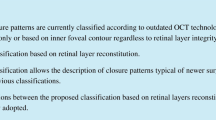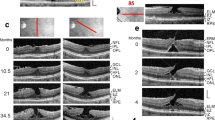Abstract
Background
The inner retinal complex is a well-defined layer in spectral-domain OCT scans of the retina. The central edge of this layer at the fovea provides anatomical landmarks that can be observed in serial OCT scans of developing full-thickness macular holes (FTMH). Measurement of the movement of these points may clarify the mechanism of FTMH formation.
Method
This is a retrospective study of primary FTMH that had a sequence of two OCT scans showing progression of the hole. Measurements were made of the dimensions of the hole, including measurements using the central edge of the inner retinal complex (CEIRC) as markers. The inner retinal separation (distance between the CEIRC across the centre of the fovea) and the Height-IRS (average height of CEIRC above the retinal pigment epithelium) were measured.
Results
Eighteen cases were identified in 17 patients. The average increase in the base diameter (368 microns) and the average increase in minimum linear dimension (187 microns) were much larger than the average increase in the inner retinal separation (73 microns). The average increase in Height-IRS was 103 microns.
Conclusion
The tangential separation of the outer retina to produce the macular hole is much larger than the tangential separation of the inner retinal layers. A model based on the histology of the Muller cells at the fovea is proposed to explain the findings of this study.





Similar content being viewed by others
References
Kelly NE, Wendel RT (1991) Vitreous surgery for idiopathic macular holes. Results of a pilot study. Arch Ophthalmol 109:654–659
Gass JDM (1995) Reappraisal of biomicroscopic classification of stages of development of a macular hole. Am J Ophthalmol 119:752–759
Stalmans P, Duker JS, Kaiser PK, Heier JS, Dugel PU, Gandorfer A, Sebag J, Haller JA (2013) OCT-based interpretation of the vitreomacular interface and indications for pharmacologic vitreolysis. Retina 33:2003–2011
Steel DHW, Lotery AJ (2013) Idiopathic vitreomacular traction and macular hole: a comprehensive review of pathophysiology, diagnosis, and treatment. Eye 27:S1–S21
Duker JS, Kaiser PK, Binder S, de Smet MD, Gaudric A, Reichel E, Sadda SR, Sebag J, Spaide RF, Stalmans P (2013) The International Vitreomacular Traction Study Group classification of vitreomacular adhesion, traction, and macular hole. Ophthalmology 120:2611–2619
Takezawa M, Toyoda F, Kambara C, Yamagami H, Kakehashi A (2011) Clarifying the mechanism of idiopathic macular hole development in fellow eyes using spectral-domain optical coherence tomography. Clin Ophthalmol 5:101–108
Ko TH, Fujimoto JG, Duker JS, Paunescu LA, Drexler W, Baumal CR, Puliafito CA, Reichel E, Rogers AH, Schuman JS (2004) Comparison of ultrahigh and standard resolution optical coherence tomography for imaging macular hole pathology and repair. Ophthalmology 111(11):2033–2043
Gentile RC, Landa G, Pons ME, Eliott D, Rosen RB (2010) Macular hole formation, progression, and surgical repair: case series of serial optical coherence tomography and time lapse morphing video study. BMC Ophthalmol 10:24
Tornambe P (2003) Macular hole genesis: the hydration theory. Retina 23:421–424
Wakely L, Rahman R, Stephenson J (2012) A comparison of several methods of macular hole measurement using optical coherence tomography, and their value in predicting anatomical and visual outcomes. Br J Ophthalmol 96(7):1003–1007
Spaide RF (2000) Closure of an outer lamellar macular hole by vitrectomy: hypothesis for one mechanism of macular hole formation. Retina 20(6):587–590
Takahashi A, Nagaoka T, Ishiko S, Kameyama D, Yoshida A (2010) Foveal anatomic changes in a progressing stage 1 macular hole documented by spectral-domain optical coherence tomography. Ophthalmology 117:806–810
Reichenbach A, Bringmann A (2010) Muller cells in the healthy retina. In: Muller cells in the healthy and diseased retina. Springer, Heidelberg, pp 35–216
Sjostrand J, Popovic Z, Conradi N, Marshall J (1999) Morphometric study of the displacement of retinal ganglion cells subserving cones within the human fovea. Graefes Arch Clin Exp Ophthalmol 237:1014–1023
Elsner AE, Weber A, Cheney MC, VanNasdale DA (2007) Spatial distribution of macular birefringence associated with Henle fibres. Vis Res 48:2578–2585
Hangai M, Ojima Y, Gotoh N, Inoue R, Yasuno Y, Makita S et al (2007) Three-dimensional imaging of macular holes with high-speed optical coherence tomography. Ophthalmology 114:763–773
Woon WH, Greig D, Savage MD, Wilson MC, Grant CA, Bishop F, Mokete B (2014) Asymmetric vitreomacular traction and symmetrical full thickness macular hole formation. Graefes Arch Clin Ex Ophthalmol. doi:10.1007/s00417-014-2884-z
Theodossiadis G, Petrou P, Eleftheriadou M, Moustakas AL, Datseris I, Theodossiadis P (2014) Focal vitreomacular traction: a prospective study of the evolution to macular hole: the mathematical approach. Eye 28(12):1452–1460
Conflict of Interest
All authors certify that they have no affiliations with or involvement in any organization or entity with any financial interest, or non-financial interest in the subject matter or materials discussed in this manuscript.
Author information
Authors and Affiliations
Corresponding author
Rights and permissions
About this article
Cite this article
Woon, W.H., Greig, D., Savage, M.D. et al. Movement of the inner retina complex during the development of primary full-thickness macular holes: implications for hypotheses of pathogenesis. Graefes Arch Clin Exp Ophthalmol 253, 2103–2109 (2015). https://doi.org/10.1007/s00417-015-2951-0
Received:
Revised:
Accepted:
Published:
Issue Date:
DOI: https://doi.org/10.1007/s00417-015-2951-0




